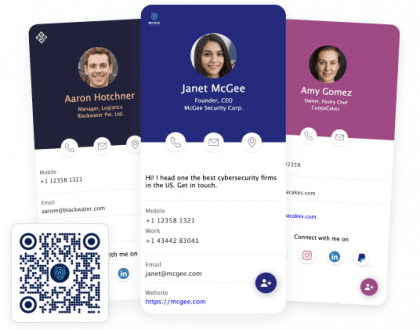How To Develop (And Maintain) Your Brand’s Tone of Voice – Print Peppermint

by IBRAHIM
How To Develop (And Maintain) Your Brand’s Tone of Voice – Print Peppermint
Establishing a brand tone of voice is important to any business marketing strategy. Maintaining a consistent brand voice helps communicate more about your business to your audience. In addition, it makes them easily relate to your business, making it a beneficial ingredient for building a successful business. Here is a step-by-step guide on how to develop a brand tone of voice and maintain it.
How to Develop Your Brand’s Tone of Voice
To find the right tone of voice, you must first understand your audience. Who are they, and what language can you use to reach them best? Once you identify your audience, identify your brand values, which will guide you in content creation and communication. By defining these elements, you can establish a clear tone of voice that your business can rely on when creating communication. Here are insights on how to develop your brand’s tone of voice.
1. Understand Your Audience

Most customers develop an emotional connection to a brand that makes them feel they are cared for. In most cases, customers feel like most businesses do not treat them as individuals. Instead, they treat them as anonymous figures in a crowd. So, when they feel considered, they are likely to connect to your brand.
To understand your audience, begin by researching who they are. Find out their;
- Age
- Gender
- Interests
- Education
- Occupation and as much information as you can access
Examine your audience’s demographic information using social networks analytics or Google analytics. Use the data to create a portrait of your audience. Remember, your audience is not always made up of buyers. So, an effective persona can help you identify the best way to communicate with your audience.
An easy way to relate better with your audience is by identifying their generation. Each generation has unique characteristics and experiences. For example, Baby Boomers are mostly at home and are embracing digital technology, while Gen X is mainly thrilled by outdoor activities. On the other hand, millennials are active on digital platforms and share similar values as Gen Z. You can understand your audience by:
a.) Discovering What They Read
Once you understand your audience and their persona, the next step is to figure out what they read. What they read regularly will shed light on the best communication method for each group.
Millennials are more active on social media platforms, and they often read their emails. Gen Z values mobile apps compared to social media and email. So, although they prioritize in-store experiences, they crave authentic and personalized brand experiences. The easiest way to reach them is through their preferred social media platforms.
When discovering what they read, your aim should be to find top social media platforms where your target audience discusses the industry you are in. Brand Monitoring is a helpful automated tool that can help you find top forums that discuss your brand and industry time.
Remember, you cannot create one social content for all platforms. Every content you create for social media should be tailored for the platform and engage your audience.
b.) Identifying How They Relate
How does your audience communicate? Follow the discussion thread your audience engages in to see what they like and dislike, the tone they use in the discussion, and their language. When you mirror their tone, communication patterns, and body language, your target audience can feel a sense of belonging. It can also help make your content more relatable and lead to an increase in sales.
For example, during a crisis, you need to be empathetic. Empathy shows your audience that you understand them and are willing to help. Therefore, do not shy away from speaking to your audience on their level or engaging with their interests. It could be an effective way to foster a long-lasting connection with them.
2. Outline Your Brand Values

Before deciding on what to write, you need to understand the primary purpose of your communication, which is driven by your company’s core values. Your core values help identify the best language you need to communicate effectively and help shape the community surrounding your brand. Here is how to outline your brand values;
a.) Outline Your Core Values
Customers will be loyal to a business they trust. Transparency is essential in building trust with your customers and can be built by understanding your company’s core values. Here are questions to help you define your core values:
- Why Did You Start That Business?
- How is your brand different from others?
- What does your business stand for?
- Do you have any shared values with your audience?
b.) Come up With a Mission Statement
Once you identify your brand values, create a brand mission statement for your audience. The statement should communicate to your readers who you are, who you care about, what your aim is and how you can help your target audience. You can also add what your business does to help better its team.
Your employees and team should operate within these values. A mission statement helps shape your brand’s culture and allows your audience to relate to your company, especially if the values are shared. It also communicates the brand purpose, objective, and how the company plans to help the audience. As your business grows over time, you might need to redo the mission statement to redefine the organization’s goal
Lastly, establish message architecture to summarize your brand communication goals. Message architecture helps content creators to communicate effectively and consistently across different forms of content.
3. Audit Your Content Creation and Communication

Before creating a brand tone, the last step is to audit your current content pieces. How does your brand sound right now and how would you like it to sound? When auditing, ask yourself if the current tone:
- Fits the brand values
- Reflects the values outlined in your mission statement
- Matches the message architecture
You should consider four dimensions when identifying the right tone of voice. Would you like the tone to be?
- Formal or casual?
- Funny or serious?
- Enthusiastic or matter-of-fact?
- Respectful or irreverent?
To ensure all your content matches the tone of voice, hire top-notch freelance writers. They can communicate in your preferred tone effectively to engage your target audience.
4. Choose a Tone of Voice that Resonates With Your Brand
Combine all the information from audience research to values and use it to define your brand tone of voice. The tone of voice should address two things- what you currently sound like and what you would like to sound like,
Firstly, choose the dimension you are aiming at, be it casual, conversational, or moderately enthusiastic. Then, choose more specific tone characteristics, e.g., playful or sarcastic. Combine the different voice characteristics and implement them in your message.
Tips to Help You Maintain a Consistent Brand Voice
Maintaining brand consistency can help increase your revenue since it fosters connection in business relationships. When you maintain a consistent brand voice, you project and instill customer confidence in your company, influencing their purchase decision. Once you have identified a brand tone of voice using the steps above, you can maintain it by following these tips.
1. Define Your Result
If you want to maintain a consistent tone of voice, understand your result. What do you expect to get? Remember that your brand voice should be dynamic to work in different places with people depending on their locale, culture, and values.
So, while your core values should remain unchanged, your voice should vary to suit each target audience. Provided your new tone of voice helps meet your goals and vision, keeping it consistent will help your brand.
2. Reflect Your Brand Core Values
How do your customers perceive you, and how would you want them to perceive you? Some companies focus on competition, others on athleticism and environmentalism. Thus, identify how you would like your audience to perceive you, and draft a message you’d like your brand to pass on to potential customers.
Customers should get a sense of your brand simply by how you communicate. Every piece of communication should outline your core values and offer a parallel experience for your customers.
3. Create a Style Guide
You should have a chart for your brand tone of voice. The guide is a constant that you should review before creating content. The guide should contain:
- A summary of your company’s brand tone of voice
- Details of brand personality
- What to write and what not to write
- A detailed breakdown of platform-specific voice instructions
- How to format content
A style guide helps maintain consistency. Every time you create content, the guide will help maintain a consistent reference to your brand irrespective of the platform. You can have a style guide for different social media channels using platforms like GatherContent. Using a channel-specific guide, your team can apply the instructions better and deliver a voice–focused copy for the different channels.
4. Use the Same Tone on Different Channels

After coming up with your brand tone and style guide, you need to be consistent and use the same tone across different channels. Make sure you closely monitor your tone as you deliver any message to your audience.
Moreover, each message should align with your brand personality and value. When you switch between tones, you will create mixed messages that could dilute your brand and confuse customers.
5. Keep Your Team in the Know

Different parties work together to make your brand a success. So, to be consistent, you need to involve them and ensure you are all working towards a common goal.
Your customers can interact with your brand in different ways. For example, the first interaction can be through voice, with your employees being a carrier. This shows that it is essential for everyone in your company to understand the brand’s tone of voice and communicate it correctly.
The brand messaging should reflect in all marketing material and different products. What’s more, it should be embedded in how leaders, employees, and other stakeholders speak about the company. When the stakeholders attach the brand tone of voice in their professional correspondence, it becomes a defined trademark associated with the presentation.
6. Define and Stick to a Writing Style

Always use a consistent written style throughout your written communications. You should consider different elements like word length. For example, you can use shorter words for a punch copy or longer words for a sophisticated copy.
You should also pay attention to the tempo. Punctuation can help control the rhythm and pace that people read with. It can also impact the tone and mood you’d like to pass. For example, shorter sentences are better for upbeat, exciting messages, while longer sentences are ideal for serious messages.
Another element you should consider is the point of view. Which perspective resonates best with your brand’s personality? You can use the first person to make the copy appear personal and more relatable. To make the copy more engaging and straightforward, you can use the second person.
Slang is also an essential element. It works best if it aligns with your brand personality. Slang can make your brand appear trendy or draw the brand closer to its target audience, and it could make your message sound confusing or unnatural if it contradicts your brand personality.
7. Humanize as You Communicate

Undoubtedly social media offers a unique opportunity for brands to communicate with potential audiences. However, to meet your marketing goals, you need to use approachable platforms. Each interaction should communicate the brand voice in a friendly and helpful way.
Therefore, always aim to use the same brand voice guidelines to remain consistent so that customers can easily tell your brand apart from competitors. A major touchpoint is to humanize your messages and empathize with your audience to connect with your audience on different platforms. When your audience sees you consistently as a human rather than a brand, you can win their trust and loyalty.
In Closing
You would like your brand to stand out among competitors and make it known for something. Developing a brand tone of voice and maintaining it makes your customers relate to your brand every time you communicate. However, to achieve this, you need to develop a clear and consistent brand voice that explains what you stand for. Our guide above will guide you in developing brand personality and maintaining consistency to ensure your brand survives and thrives!
Jade Bloom
Chief Marketing Officer
Jade Bloom, the marketing director for the Content Panel, is an avid bibliophile who spends much of her time in bookstores, eagerly searching for the next bestseller to consume.
Recommended Posts

SeidrLab visual identity by Mubien Brands
October 16, 2023




